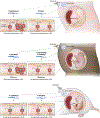Malaria in pregnancy: the relevance of animal models for vaccine development
- PMID: 28984865
- PMCID: PMC6771290
- DOI: 10.1038/laban.1349
Malaria in pregnancy: the relevance of animal models for vaccine development
Abstract
Malaria during pregnancy due to Plasmodium falciparum or P. vivax is a major public health problem in endemic areas, with P. falciparum causing the greatest burden of disease. Increasing resistance of parasites and mosquitoes to existing tools, such as preventive antimalarial treatments and insecticide-treated bed nets respectively, is eroding the partial protection that they offer to pregnant women. Thus, development of effective vaccines against malaria during pregnancy is an urgent priority. Relevant animal models that recapitulate key features of the pathophysiology and immunology of malaria in pregnant women could be used to accelerate vaccine development. This review summarizes available rodent and nonhuman primate models of malaria in pregnancy, and discusses their suitability for studies of biologics intended to prevent or treat malaria in this vulnerable population.
Figures


Similar articles
-
Folic acid supplementation and malaria susceptibility and severity among people taking antifolate antimalarial drugs in endemic areas.Cochrane Database Syst Rev. 2022 Feb 1;2(2022):CD014217. doi: 10.1002/14651858.CD014217. Cochrane Database Syst Rev. 2022. PMID: 36321557 Free PMC article.
-
Guidelines and considerations for testing malaria vaccines in pregnant women.Hum Vaccin. 2010 Jan;6(1):21-6. doi: 10.4161/hv.6.1.10331. Epub 2010 Jan 15. Hum Vaccin. 2010. PMID: 19946207 Review.
-
Development and Evaluation of a Cryopreserved Whole-Parasite Vaccine in a Rodent Model of Blood-Stage Malaria.mBio. 2021 Oct 26;12(5):e0265721. doi: 10.1128/mBio.02657-21. Epub 2021 Oct 19. mBio. 2021. PMID: 34663097 Free PMC article.
-
Persistence and immunogenicity of chemically attenuated blood stage Plasmodium falciparum in Aotus monkeys.Int J Parasitol. 2016 Aug;46(9):581-91. doi: 10.1016/j.ijpara.2016.05.002. Epub 2016 May 26. Int J Parasitol. 2016. PMID: 27238088
-
Malaria Surveillance - United States, 2016.MMWR Surveill Summ. 2019 May 17;68(5):1-35. doi: 10.15585/mmwr.ss6805a1. MMWR Surveill Summ. 2019. PMID: 31099769
Cited by
-
Contribution of Murine Models to the Study of Malaria During Pregnancy.Front Microbiol. 2019 Jun 19;10:1369. doi: 10.3389/fmicb.2019.01369. eCollection 2019. Front Microbiol. 2019. PMID: 31275284 Free PMC article. Review.
-
Plasmodium falciparum in Aotus nancymaae: A New Model for Placental Malaria.J Infect Dis. 2022 Aug 26;226(3):521-527. doi: 10.1093/infdis/jiac096. J Infect Dis. 2022. PMID: 35290467 Free PMC article.
-
Aotus nancymaae model predicts human immune response to the placental malaria vaccine candidate VAR2CSA.Lab Anim (NY). 2023 Dec;52(12):315-323. doi: 10.1038/s41684-023-01274-2. Epub 2023 Nov 6. Lab Anim (NY). 2023. PMID: 37932470 Free PMC article.
-
Asymptomatic malaria infection and its associated factors among pregnant women in Ethiopia; a systematic review and meta-analysis.Parasite Epidemiol Control. 2024 Jan 27;24:e00339. doi: 10.1016/j.parepi.2024.e00339. eCollection 2024 Feb. Parasite Epidemiol Control. 2024. PMID: 38323191 Free PMC article. Review.
-
Potential pharmacologic interventions targeting TLR signaling in placental malaria.Trends Parasitol. 2022 Jul;38(7):513-524. doi: 10.1016/j.pt.2022.04.002. Epub 2022 May 7. Trends Parasitol. 2022. PMID: 35537977 Free PMC article. Review.
References
-
- Rogerson SJ, Hviid L, Duffy PE, Leke RF & Taylor DW Malaria in pregnancy: pathogenesis and immunity. Lancet Infect. Dis. 7, 105–117 (2007). - PubMed
-
- Desai M et al. Epidemiology and burden of malaria in pregnancy. Lancet Infect. Dis. 7, 93–104 (2007). - PubMed
-
- Nosten F, ter Kuile F, Maelankirri L, Decludt B & White NJ Malaria during pregnancy in an area of unstable endemicity. Trans. R. Soc. Trop. Med. Hyg. 85, 424–429 (1991). - PubMed
-
- Menendez C et al. The impact of placental malaria on gestational age and birth weight. J. Infect. Dis. 181, 1740–1745 (2000). - PubMed
Publication types
MeSH terms
Substances
Grants and funding
LinkOut - more resources
Full Text Sources
Other Literature Sources
Medical

